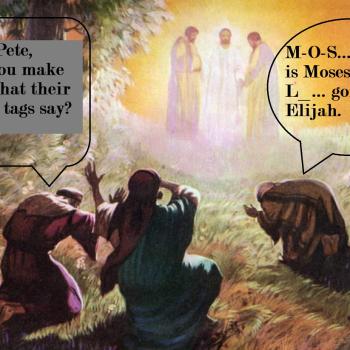When I saw that there would be a Patheos Book Club on Rabbi David Zaslow’s book Jesus: First-Century Rabbi
, I knew I had to participate. Not only the subject of the historical figure of Jesus, but also the relationship of Christian origins to its Jewish matrix, interest me both professionally and personally.
The cover material of Zaslow’s book suggests that it is about the historical Jesus. If one reads it with that expectation, there will probably be some disappointment. Rarely does the author express skepticism about the historicity of details in either the Gospels or ancient Jewish sources, or acknowledge critical scholarship’s conclusions regarding the unlikelihood that Paul wrote 1 Timothy). But what Zaslow does offer – a presentation of the profoundly Jewish character of Jesus’ teaching, and the depiction of him and his family as devout Jews in early sources – is useful not so much as an exercise in historical criticism, but as a recontextualization of Jesus to show that, whatever he may be to Christians, Jesus is a Jewish figure who can and should be appreciated by Jews as part of their own history, and not ignored or rejected as merely part of the history of others.
The book is not an effort at historical reconstruction, but at inter-religious dialogue of a positive sort, one that seeks to respond to Christianity’s history of anti-Semitism and supersessionism or “replacement theology,” by articulating how Judaism is in fact the root and Christianity a branch from it. He thus offers an exposition of Jesus’ sayings in comparison with Talmudic and Midrashic sources. There is also an attempt to explain Jewish theology in terms that Christians may understand, and express a Jewish view of some some key Christian tenets.
Although Zaslow describes how he learned the lesson that it is inadvisable to try to describe someone else’s faith tradition, this doesn’t altogether prevent him from doing just that. One example of the pitfalls of doing so is found on p.35, where he says that “One of the major underlying differences between Judaism and Christianity is that every Jewish denomination is in some way engaged with an ancient oral tradition in addition to written Scripture.” The role of tradition and of its preservation in writing in the Mishnah and elsewhere has close parallels with at least some strands of Christianity – and arguably with all of them, in different ways.
There were also some insightful – but also some extremely problematic – attempts to suggest that texts could be translated in a different manner more aligned with Judaism. An example of the latter is the discussion of “I am the way…” in John 14:6. It is extremely unlikely that Jesus said the words attributed to him in the Gospel of John, and it is also unlikely that Jesus or the author of John meant “I am (=God), the way…”
The book is at its best when it is pointing out parallels to the teaching of Jesus, and when it is illustrating the richness of the Jewish tradition. I loved Zaslow’s discussion of the Akedah, including a personal anecdote (pp.91-93). That story from Genesis was the reading at his son’s bar mitzvah. His son asked him what he would do if God told him to do what the story says God told Abraham to do. Rabbi Zastrow’s response was this:
Ari, if God asked me to do that, and I was really positive it was God and not my imagination; if I was one hundred percent certain it was God and that I was not just hearing voices inside my own head; if I was totally positive it was Adonai, I would say, ‘God, forget about it! No way, God! I would never do that to my son. I love you and I love my son, and you already tested Abraham anyway – that’s enough testing!
The books is worth reading, both for Jews interested in a positive Jewish perspective on Jesus, and for Christians interested in an assessment of their faith and its central figure by a Jewish rabbi. It isn’t a definitive treatment of the intersection between the two traditions, nor a thorough scholarly argument. It is a popular-level and personal exploration, and when considered as such, it works well as a starting point and a resource for crucial conversations between Jews and Christians.














